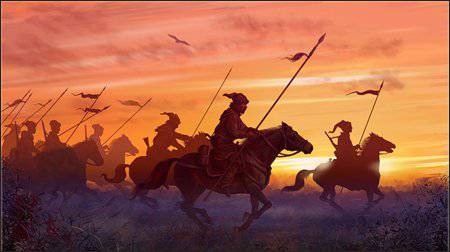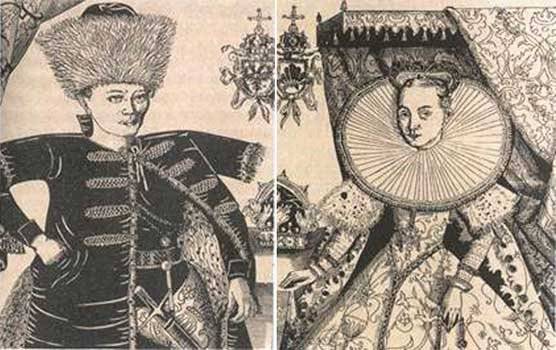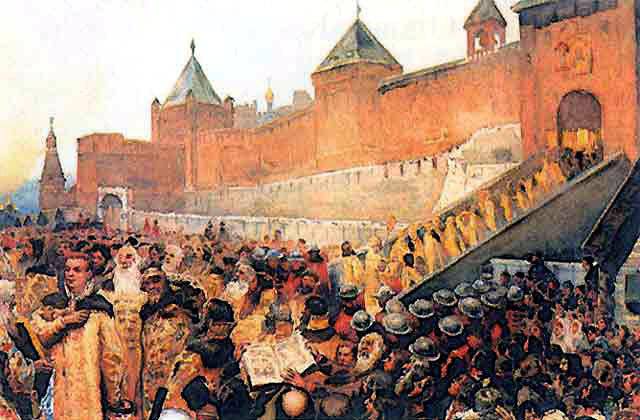Time of Troubles and the Cossacks
 During the reign of Fyodor Ivanovich (1584-1598), Russia's power continued to grow. The Russian-Swedish 1590-1593 war ended in victory, the cities lost after the Livonian campaign were returned: Yam, Koporye, Ivangorod, Oreshek, Korela. In August 1591, the Crimean horde was defeated, which wanted to take advantage of the war between Moscow and Sweden. Important in the role played in the battle of the Don Cossacks. When the Crimean army reached out to Moscow, they hit the enemy rear areas: the reserves of the Krymchaks were defeated, 7 thousand people were taken prisoner, 17 thousand horses were captured. And after that the Cossacks moved to the Crimea. This news caused panic among the Tatars, and they began to retreat, then ran.
During the reign of Fyodor Ivanovich (1584-1598), Russia's power continued to grow. The Russian-Swedish 1590-1593 war ended in victory, the cities lost after the Livonian campaign were returned: Yam, Koporye, Ivangorod, Oreshek, Korela. In August 1591, the Crimean horde was defeated, which wanted to take advantage of the war between Moscow and Sweden. Important in the role played in the battle of the Don Cossacks. When the Crimean army reached out to Moscow, they hit the enemy rear areas: the reserves of the Krymchaks were defeated, 7 thousand people were taken prisoner, 17 thousand horses were captured. And after that the Cossacks moved to the Crimea. This news caused panic among the Tatars, and they began to retreat, then ran.It should be noted that Boris Godunov (in 1587 — 1598 years, the de facto ruler of Russia, with a sick king, since February 1598, was elected king) was one of the first rulers who tried to lead the kingdom along the western path of development. So, with regard to the Cossacks, he decided to repeat the experience of Poland, turning them into ordinary subjects. In 1593, Don received an order to live in peace with the Turks in Azov, to release all prisoners. To manage the Don army was supposed to royal commissioner - a nobleman Peter Khrushchev. The Cossack circle refused to accept him. Godunov was pissed off and sent Prince Volkonsky with a letter, promising disobedience to disgrace and execution, even threatening to disperse the Don Cossacks, sending the tsarist army to conclude an alliance with the Turks against the Cossacks.
At the same time, Cossack Nekhoroshko Kartavy arrived from Moscow and reported about the plight of Don in the tsar's service - they did not pay salaries, they did not give me food, they did not let Don don, some were turned into serfs. The Cossacks were offended and denied Godunov a “service.”
Godunov began to pursue a repressive policy against the Don Cossacks: the Cossacks were forbidden to appear in Russian cities, where they were trading, although some families lived there. Voivods attributed to catch the Cossacks, imprisoned or even executed. At Seversky Donets began to build a fortress directed against the Cossacks - Tsaryov-Borisov. Moreover, they began to form detachments of volunteers who made raids on the lands of the Don Cossacks and caught the Cossacks. In response, Don made an alliance with the Cossacks — they decided to “stand for one.” And he responded with a blow to the blow - a Cossack detachment took and burned Voronezh. In fact, the war began in Moscow and the Don Cossacks.
The government of Godunov not only spoiled relations with the Dontians, but also with other estates. The peasantry in Russia was free (fully or with some restrictions), Godunov decided to enslave them on the model of the peasants of the German states, Poland, the Baltic states. In 1593, they were forbidden to leave on St. George’s Day (November 26), in 1597, a search was made for fugitives. In addition, a law was established according to which any free person who worked for more than six months for hire became hereditary slave. This was taken advantage of by the boyars, the royal approximate, the nobles, specifically sought and strongly lured experienced craftsmen, it happened that they even seized people on the road, extorting them to sign a bondage.
Godunov managed to quarrel and with the upper classes, after being elected to the throne in 1598, he began repressions against possible opponents, Romanovs were disgraced (Fyodor Romanov was tonsured as a monk under the name of Philaret, others were exiled, and some died imprisoned), Nagy, Belsky , Shuisky, Mstislavsky, Cherkassky, Vorotynsky, etc. The informing was widespread: a serf who had brought against his nobleman, could get his estate. Citizens suffered as well - Godunov increased taxes and introduced the western system of paying for cities to individuals.
As a result, almost all classes were somehow offended. The situation was aggravated by the 1601-1602 natural disaster, when due to the quirks of nature two years in a row there was a poor harvest. The country was struck by a terrible famine, only in Moscow alone, the dead went to tens of thousands of people. The situation was so difficult that the nobles released to freedom (often to starvation) slaves and serfs, they had nothing to feed. Others ran themselves. The country was flooded with crowds of vagrants, brigands, a sure sign of the Troubles.
When the situation began to stabilize, they began to search for and return the fugitives. The Klopko (Khlopa) uprising began, it swept the counties of the west, center and south of the country. And the troops of the rebels went to Moscow, but were defeated on September 9, 1603, by the royal troops under the command of okolnichy I.F. Basmanov (the okolnichy himself fell in this battle, and the seriously wounded Cotton was captured, where he died). Part of the rebels fled to the south, others were captured and executed.
The South became the center of attraction for the disgruntled, disgraced nobles were exiled here, runaway peasants and serfs ran here, because the elements did not affect this territory, there were not enough people here, therefore people looked at their origins with the help of their fingers. To the south, the remnants of the defeated insurgent detachments fled. Cossacks hostile to Moscow were near, as a result, South of Russia became a kind of “powder keg”, to which it remained only to bring the fuse down.
False Dmitry I
This falsehood was False Dmitry I. According to the official version of the government of Boris Godunov, it was a fugitive monk of the Chudov Monastery Gregory Otrepyev (a nobleman by birth). Although there are other versions: according to the contemporaries of the events of the court historiographer of the Swedish king Charles IX, Johan Vidkind, the author of the book of memoirs, known as “Stories the ten-year Swedish-Muscovite war ", it was a protege of the Poles, Valah or Italian by origin (possibly a Jew). Another contemporary of events, a German mercenary in the Russian service, Konrad Bussow, believed that he was the illegitimate son of the Polish king Stephen Batory, who died in 1586 in the year. He was supposedly taught by the escaped monk Gregory Otrepiev.
Only one thing can be said for sure - it was not the “true prince” Dmitry. Opponents of the version of Gregory Otrepiev celebrate European skills, unusual for a monk from Russia. In addition, they noticed that it is attached to images and creates a sign not according to Russian custom, rarely goes to the bath (which is more typical of Europeans of that time), the impostor talked about Polish education. Perhaps the impostor was from the Russians, who lived in Poland, and became a “Trojan horse”, which was specially prepared by Jesuit monks. This is confirmed by the fact that behind the False Dmitry were such figures as Pope Paul V, King of Poland and Grand Duke of Lithuania Sigismund III, Jesuit Order, Polish magnates Adam Vishnevetsky and Mnishek.

False Dmitry I and Marina Mnishek. Engravings from portraits of F. Snyadetsky. Early 17th century
The outbreak of war
In October, 1604, a squad of impostor invaded the Moscow kingdom. Initially, the company looked like a complete gamble. He had only 1,5-2 thousand Polish mercenaries, 2 thousand Cossacks and a small detachment of Don. The detachment did not have artillery; the Crimean Khan Kazy-Girey did not strike in the South.
But almost immediately, the cities of Chernigov, Moravsk, Putivl, then Rylsk, Kursk, Sevsk, Kromy began to cross over to the side of the impostor. Tsarist army of Prince F.I. Mstislavsky (50 thousand) could not break the units of False Dmitry (up to 15 thousand) 18 December 1604 of the year near Novgorod-Seversky.
The Cossacks supported the impostor, not only the Zaporozhye and Don, but also the serving ones, although many peasant detachments called themselves Cossacks. The governors of the surrendered Russian cities either swore to the False Dmitry themselves, or were taken prisoners to his camp, but they were immediately released and they took the oath. The impostor's army was constantly growing.
21 January 1605, in the battle of Dobrynichy, the pretender's army was defeated. In many respects, this was due to the flight of detachments of peasants; the tsarist troops needed only to drive them and chop them down. Here Godunov and his commanders made a mistake - his troops unleashed terror, and not only against the rebels, but simply sympathizers, they did not spare even women and children. As a result, anti-government sentiment intensified. The Cossacks and in defeat did not abandon the False Dmitry, the ataman of Karela with a detachment of 4 thousand people (of which there were hundreds of 6 cossacks) in the Kromy fortress bound the initiative of the whole tsarist army.
But the final success of the impostor was determined not by the Cossacks, not by the mistakes of the government and the governor Godunov, but by the hatred of Boris of the majority of the population and his unexpected death on April 13 of the year. Immediately, a conspiracy arose among the boyars and the governor, the son of Boris Godunov, Fyodor, was overthrown and killed, and the army that stood under Kromi went over to the side of the impostor (commander of the army of the governor Petr Fedorovich Basmanov later became one of his closest associates). 1605 June 20, the False Dmitry triumphantly entered the Kremlin.

K.F. Lebedev. The entry of the False Dmitry I troops into Moscow.
Information